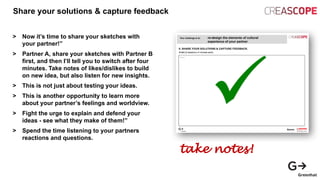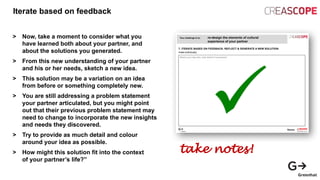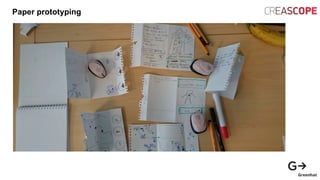Design thinking process explained
- 1. DESIGN THINKING: the Process that Can Radically Change the Way You Innovate Rafał Kołodziej 14/07/2017
- 2. Who we are? Creating positive change through focusing organizations on human needs. DESIGNING DIRECTION OF CHANGE DESIGNING INNOVATION PREPARING ORGANIZATIONS TO ADOPT CHANGE FUTURES THINKING VALUE PROPOSITION DESIGN DISCOVERING UN-MET NEEDS INNOVATION STRATEGY PRODUCT & SERVICE DESIGN CUSTOMER JOURNEY DESIGN UNIQUE EXPERIENCES DESIGN TESTING PROTOTYPES DESIGNING INNOVATION CULTURE TUNING INTERNAL INNOVATION PROCESSES DESIGNING INTERNAL R&D IN SME INNOVATORS’ CONTRACTORY
- 3. How do we do? HUMAN-CENTERED APPROACH LEAN SERVICE DESIGN CUSTOMER BEHAVIOR FUTURES THINKING Creating positive change through focusing organizations on human needs.
- 4. Edwin Bendyk, Jerzy Hausner, Michał Kudłacz „MIASTO – IDEA. Nowe podejście do rozwoju miast” „You cannot first understand the problem to solve it anymore. You have to start to solve it to understand it.”
- 6. Our last ’design thinking’ challenges in Greenhat City: how to prepare City of Poznań for the challenges of future? National Park: how to make tourists not trespass prepared tracks? Court: how to make minimize stress of people entering the court? Bank: how to make people want spend more of their time in a bank branch? Insurance: how to make people understand the idea, benefits and mechanism of insurance?
- 7. „Design Thinking is a human-centered approach to innovation.” Tim Brown, IDEO
- 8. Innovation is a sequence of iterative approximations in the area of MIGHT be.
- 10. EMPATHIZE DEFINE DEVELOP DELIVER IMPLEMENT DEFINE NEEDS NAME PROBLEM PROTOTYPE AND TEST BUILD SOLUTION PPlanB PLAN GO LIVE Research Personas Problem definition Filtering information Prototyping Testing with users BRIEF Challenge or problem Gathering information around the problem area Observations Diagnostic workshops Design challenge Building solutions Generating ideas Solution adjusting Data analysis and problem definition Building solution (prototypes) Testing prototypes and developing final solution Solution ready for implementation
- 11. “Learning is the process whereby knowledge is created through the transformation of experience.” Dr David Kolb
- 12. The way an adult learns
- 13. Instead of just telling you about design thinking, I want to immediately have you jump right in and experience it for yourself. I am going to do a design project for about the next hour.
- 14. So let’s experience it first :)
- 16. Your challenge is to: re-design the elements of cultural experience of your partner.
- 17. You can easily download this Design Thinking training https://dschool.stanford.edu/s/Facilitators-Guide_Design-Thinking.pdf
- 19. Start with the reflection of your cultural experience > When have you been to any concert, exhibition, in a museum, theatre? > Why have you chosen this event? > Have you been there alone / in a company? > Had you planned this visit before or was it a spontaneous jump-out? > How have you bought the ticket? > Have you used any guidance? > Did you feel warm? Cold? Did you feel any smell? What colour you associate with it? > How much time did you spend there? > What made you anxious? > Was there anything dedicated to you? > What did you tell your friends of it? take notes!
- 20. Now ask your partner to tell about his/her experience > When have you been to any concert, exhibition, in a museum, theatre? > Why have you chosen this event? > Have you been there alone / in a company? > Had you planned this visit before or was it a spontaneous jump-out? > How have you bought the ticket? > Have you used any guidance? > Did you feel warm? Cold? Did you feel any smell? What colour you associate with it? > How much time did you spend there? > What made you anxious? > Was there anything dedicated to you? > What did you tell your friends of it? take notes!
- 21. Dig deeper > Try to dig for stories, feelings, and emotion. > Ask ‘WHY?’ as often as possible. take notes!
- 23. Re-frame the problem Work individually – take 3 minutes to collect your thoughts and reflect on what you’ve heard. > Try to synthesize your learning into a few ‘needs’ that you have discovered, and a few ‘insights’ that you find interesting. > ‘Needs’ should be verbs. > For example maybe your partner needs to feel like they have a knowledge of the people that already participated. > “Insights” are discoveries that you might be able to leverage when creating solutions. > For example, you might have discovered the insight that your partner views events with audience participation more meaningful and attractive. take notes!
- 24. Re-frame the problem Define the problem statement > This is the statement that you’re going to address with your design, so make sure it’s juicy and actionable! > It should feel like a problem worth tackling! take notes!
- 26. Generate alternatives to test > Re-write the problem definition from the previous page. Have a second look at it. > Now you are creating solutions to the new challenge you’ve identified. > You have 5 minutes to sketch as many ideas as possible. GO FOR VOLUME! > This is time for idea generation, not evaluation - you can evaluate your ideas later. > Let’s see who of you can come up with at least 7 ideas! J > Remember to be VISUAL - use words just when necessary to call out details. > Try to sketch wildly different ways to address your problem statement!. Draw solutions
- 27. Share your solutions & capture feedback > Now it’s time to share your sketches with your partner!” > Partner A, share your sketches with Partner B first, and then I’ll tell you to switch after four minutes. Take notes of likes/dislikes to build on new idea, but also listen for new insights. > This is not just about testing your ideas. > This is another opportunity to learn more about your partner’s feelings and worldview. > Fight the urge to explain and defend your ideas - see what they make of them!” > Spend the time listening to your partners reactions and questions. take notes!
- 29. Iterate based on feedback > Now, take a moment to consider what you have learned both about your partner, and about the solutions you generated. > From this new understanding of your partner and his or her needs, sketch a new idea. > This solution may be a variation on an idea from before or something completely new. > You are still addressing a problem statement your partner articulated, but you might point out that their previous problem statement may need to change to incorporate the new insights and needs they discovered. > Try to provide as much detail and colour around your idea as possible. > How might this solution fit into the context of your partner’s life?” take notes!
- 30. Iterate based on feedback > Now, take a moment to consider what you have learned both about your partner, and about the solutions you generated. > From this new understanding of your partner and his or her needs, sketch a new idea. > This solution may be a variation on an idea from before or something completely new. > You are still addressing a problem statement your partner articulated, but you might point out that their previous problem statement may need to change to incorporate the new insights and needs they discovered. > Try to provide as much detail and colour around your idea as possible. > How might this solution fit into the context of your partner’s life?” take notes!
- 31. Build your solution > Create a physical prototype of your solution. > Try to create an experience that their partner can react to (not only a static model). > MAKE something that your partner can engage and interact with. > If your solution is a service or a system, create a scenario that allows your partner to experience this innovation. > Use whatever materials are available to you - including space!” > Be scrappy and quick - you only have 7 minutes!!!”
- 32. Share your solution and get feedback > Share your prototype with your partner :) > Validation of the prototype is not the point - it should be an artifact that facilitates a new, targeted conversation. > When you test, LET GO of your prototype, physically and emotionally. > Your prototype is NOT PRECIOUS, but the feedback and new insights it draws out are! > DON’T DEFEND your prototype; instead, watch how your partner uses and misuses it. take notes!
- 33. Put all the prototypes in the center of the room J
- 34. EMPATHIZE DEFINE DEVELOP DELIVER IMPLEMENT DEFINE NEEDS NAME PROBLEM PROTOTYPE AND TEST BUILD SOLUTION PPlanB PLAN GO LIVE Research Personas Problem definition Filtering information Prototyping Testing with users BRIEF Challenge or problem Gathering information around the problem area Observations Diagnostic workshops Design challenge Building solutions Generating ideas Solution adjusting Data analysis and problem definition Building solution (prototypes) Testing prototypes and developing final solution Solution ready for implementation
- 35. EMPATHIZE DEFINE DEVELOP DELIVER IMPLEMENT To create meaningful innovations, you need to know your users and care about their lives. Framing the right problem is the only way to create the right solution. It’s not about coming up with the ‘right’ idea, it’s about generating the broadest range of possibilities. Build to think and test to learn. Testing is an opportunity to learn about your solution and your user. DEFINE NEEDS NAME PROBLEM PROTOTYPE AND TEST BUILD SOLUTION
- 36. The way an adult learns
- 37. Any project always starts with the hair ball of possibilities TIAL | Poznan | 2013 HE HAIR BALL OF POSSIBILITIES
- 38. An acceptable solution is usually found… TIAL | Poznan | 2013 TRATEGY
- 39. CLIENT …and then you launch your brilliant product/service! TIAL | Poznan | 2013 TRATEGY
- 40. Servicedesignthinkingisaniterativeprocess. TheSquiggle byDamienNewman ServiceDesignThinking CLIENT Ups… something unexpected happens... Why? TIAL | Poznan | 2013 TRATEGY
- 41. TIAL | Poznan | 2013 TRATEGYHuman-centred design process changes the way we innovate CLIENT CLIENT CLIENT CLIENT
- 42. It is the inside (not outside) where magic happens We start with individuals …trying to understand different points of view. CONFIDENTIAL | Poznan | 2013 POINTS OF VIEW TRANS- DYCYPLINARITY
- 43. It is the inside (not outside) where magic happens …then comes empathy that changes the initial positions of a team members and opens for new way of thinking. TRANS- DYCYPLINARITY CONFIDENTIAL | Poznan | 2013 TEAM EMPATHY
- 44. It is the inside (not outside) where magic happens …and we finish with a team that works out a non-expected common sense solution.
- 45. The way an adult learns
- 46. EMPATHIZE DEFINE DEVELOP DELIVER IMPLEMENT To create meaningful innovations, you need to know your users and care about their lives. Framing the right problem is the only way to create the right solution. It’s not about coming up with the ‘right’ idea, it’s about generating the broadest range of possibilities. Build to think and test to learn. Testing is an opportunity to learn about your solution and your user. DEFINE NEEDS NAME PROBLEM PROTOTYPE AND TEST BUILD SOLUTION
- 47. EMPATHIZE To create meaningful innovations, you need to know your users and care about their lives. Empathy is the centrepiece of a human-centered design process. Empathize mode is the work you do to understand people, within the context of your design challenge.
- 48. Putting human (consumer, user) in the centre of any activities and being driven by value we deliver. USER USER-CENTRED DESIGN OBSERVATION SHADOWING DIARIESSERVICE SAFARIS BLOGS CO-CREATIVE WORKSHOPS ETHNOGRAPHY CONTEXTUAL INTERVIEW BECOMING THE USER
- 49. Observe View users and their behaviour in the relevant context of their lives. Engage Talk to people. Keep the conversation loosely. Always ask “Why?” to uncover deeper meaning Watch and Listen Ask to show you how to complete a task. Physically go through the steps, and talk you through why they are doing what they do.
- 50. EMPATHIZE DEFINE To create meaningful innovations, you need to know your users and care about their lives. Framing the right problem is the only way to create the right solution. TRANSITION You need to process all the things you heard and saw in order to understand the big picture and grasp the takeaways of it all.
- 51. EMPATHIZE DEFINE DEVELOP DELIVER IMPLEMENT To create meaningful innovations, you need to know your users and care about their lives. Framing the right problem is the only way to create the right solution. It’s not about coming up with the ‘right’ idea, it’s about generating the broadest range of possibilities. Build to think and test to learn. Testing is an opportunity to learn about your solution and your user. DEFINE NEEDS NAME PROBLEM PROTOTYPE AND TEST BUILD SOLUTION
- 52. The Define mode is all about bringing clarity and focus to the design space. It is the chance to define the challenge you are taking on, based on what you have learned about your user and context. DEFINE Framing the right problem is the only way to create the right solution.
- 53. DEFINE Framing the right problem is the only way to create the right solution. How to help (whom?) ............................................................. solve a problem (with?) ……………….................................. ........................................................................................................................... to gain (effect) ……………………………………………….………………….. Problem statement
- 54. DEVELOP It’s not about coming up with the ‘right’ idea, it’s about generating the broadest range of possibilities. TRANSITION A well-scoped and -articulated point-of-view will lead you into ideation in a very natural way. Create a list of “How-Might-We?” brainstorming topics that flow from your problem statement. DEFINE Framing the right problem is the only way to create the right solution.
- 55. EMPATHIZE DEFINE DEVELOP DELIVER IMPLEMENT To create meaningful innovations, you need to know your users and care about their lives. Framing the right problem is the only way to create the right solution. It’s not about coming up with the ‘right’ idea, it’s about generating the broadest range of possibilities. Build to think and test to learn. Testing is an opportunity to learn about your solution and your user. DEFINE NEEDS NAME PROBLEM PROTOTYPE AND TEST BUILD SOLUTION
- 56. The Development mode it’s not about coming up with the ‘right’ idea, it’s about generating the broadest range of possibilities. Mentally it represents a process of “going wide” in terms of concepts and outcomes. DEVELOP It’s not about coming up with the ‘right’ idea, it’s about generating the broadest range of possibilities.
- 57. DEVELOP It’s not about coming up with the ‘right’ idea, it’s about generating the broadest range of possibilities. 99 IDEAS IN 60 MINUTES :)
- 58. DEVELOP It’s not about coming up with the ‘right’ idea, it’s about generating the broadest range of possibilities. FUEL YOUR CREATIVITY WITH TRENDS
- 59. EMPATHIZE DEFINE DEVELOP DELIVER IMPLEMENT To create meaningful innovations, you need to know your users and care about their lives. Framing the right problem is the only way to create the right solution. It’s not about coming up with the ‘right’ idea, it’s about generating the broadest range of possibilities. Build to think and test to learn. Testing is an opportunity to learn about your solution and your user. DEFINE NEEDS NAME PROBLEM PROTOTYPE AND TEST BUILD SOLUTION
- 60. DELIVER Build to think and test to learn. Testing is an opportunity to learn about your solution and your user. TRANSITION Employ a process of considered selection, by which you bring multiple ideas forward into prototyping and testing, thus maintaining your innovation vivid. DEVELOP It’s not about coming up with the ‘right’ idea, it’s about generating the broadest range of possibilities.
- 61. Storyboard
- 63. App mock-ups
- 64. Low-fi mock-ups
- 66. Role playing
- 67. Service origami
- 68. Test it quick and cheap
- 69. EMPATHIZE DEFINE DEVELOP DELIVER IMPLEMENT To create meaningful innovations, you need to know your users and care about their lives. Framing the right problem is the only way to create the right solution. It’s not about coming up with the ‘right’ idea, it’s about generating the broadest range of possibilities. Build to think and test to learn. Testing is an opportunity to learn about your solution and your user. DEFINE NEEDS NAME PROBLEM PROTOTYPE AND TEST BUILD SOLUTION
- 70. The way an adult learns
- 71. EMPATHIZE DEFINE DEVELOP DELIVER IMPLEMENT To create meaningful innovations, you need to know your users and care about their lives. Framing the right problem is the only way to create the right solution. It’s not about coming up with the ‘right’ idea, it’s about generating the broadest range of possibilities. Build to think and test to learn. Testing is an opportunity to learn about your solution and your user. DEFINE NEEDS NAME PROBLEM PROTOTYPE AND TEST BUILD SOLUTION
- 72. „Design Thinking is a human-centered approach to innovation.” Tim Brown, IDEO
- 73. The way an adult learns
- 74. “Learning is the process whereby knowledge is created through the transformation of experience.” Dr David Kolb
- 75. Some books worth reading
- 76. Hands on! Rafał Kołodziej CEO M +48 600 305 158 E [email protected]












































































